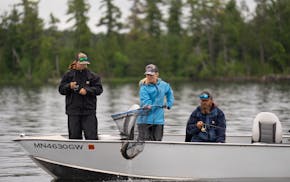Once-rare lake trout in Lake Superior are doing so well that state biologists will use the fish to stock the species in lakes around the state, officials have announced.
This fall, the Department of Natural Resources successfully harvested lake trout eggs from fish captured in two nets set along the North Shore just north of Duluth. Crews transported 18 male-female pairs to the DNR work station at the French River, stripping them of eggs and milt. The fish were then returned to the lake.
Cory Goldsworthy, DNR Lake Superior fisheries supervisor, said the trial has given the agency confidence to vacate its previous and less efficient lake trout stocking routine. For about 20 years, crews have taken long trips each fall to Mountain Lake — a deep-water inland lake on the Canadian border — to net the fish needed to fulfill Minnesota's lake trout stocking needs.
The change, starting next fall, will be historic because lake trout in Lake Superior were ready to collapse in the early 1960s from over-fishing and devastation from the invasive sea lamprey. Joint efforts by conservation partners throughout the Great Lakes culminated around 2017 with full revival of the species and a return to commercial fishing of the species in Minnesota waters.
"It's kind of a good story to tell,'' Goldsworthy said this week. "We busted our butts to rehabilitate lake trout in Lake Superior and now the population is doing so well we are using those adult fish for inland stocking programs.''
The news about capitalizing on the turnaround of lake trout in Lake Superior coincides with the opening of the annual sport fishing season. Opening day was Sunday in the Minnesota and Wisconsin waters of the big lake, and the season runs into October of next year. The Minnesota daily bag limit on Lake Superior is three lake trout of any size. Inland lake trout fishing in Minnesota opens Dec. 30 for lakes entirely inside the Boundary Waters Canoe Area. For other inland lakes, the season opens Jan. 13. All inland fishing of lake trout in Minnesota ends March 31.
Goldsworthy said the comeback of lake trout along the North Shore and elsewhere in Lake Superior has proven durable, buoyed most recently by a giant boom in lake herring, also called cisco, a key forage species. The 2022 population boom in ciscoes should provide stable nutrition for lake trout for another 20 years, Goldsworthy said.
The state halted the stocking of lake trout into Lake Superior in 2015 because natural reproduction was doing so well. By now, at least 98% of the population is wild, or naturally produced. In 1980, only 6% of the population was wild.
In the most recent annual fisheries report for the Minnesota waters of Lake Superior, the DNR recorded a catch of 16.6 lake trout per 1,000 feet of net in the fall of 2023. That was the fourth-best catch in the previous 10 years. The same survey recorded the highest number of juvenile lake trout netted since 2005 – another sign of strength.
Paula Phelps, the DNR's fish production supervisor, said tapping Lake Superior for the gametes needed to raise baby lake trout would ideally allow the system to discontinue keeping adult broodstock on hand in the Peterson State Fish Hatchery in southeastern Minnesota.
She said it's too early to say how many fingerlings and yearlings can be raised in the hatchery each year with the new method. But initially, the plan calls for the North Shore crew to produce enough fertilized lake trout eggs to stock the seven inland lakes currently in the DNR's rotation. The eggs will be transported to the Peterson hatchery for raising.
Additional lake trout stocking could be achieved, Phelps said, if the Lake Superior strain of lake trout proves successful within the hatchery system and resilient in lakes. She said the Mountain Lake strain of lake trout in use now has failed to thrive in some stocked lakes.
"It could expand the number of lakes to be stocked,'' Phelps said. "That's the hope.''
Currently, the DNR stocks seven Minnesota lakes with lake trout. They are Pennington Mine, Sagamore Mine and Big Trout Lake in the greater Brainerd area, Little Trout and Gun lakes near International Falls, Grindstone Lake in the Hinckley area and Iron Chief Complex near Buhl.

Xcel lets loose a small army of hungry sheep to keep its solar farm in order

Anderson: In early June, Minnesota fish are begging to be caught. Won't you help?

So you want to get an e-bike? Here's what you should know in Minnesota
Baby opossums are emerging from their mothers' pouches

